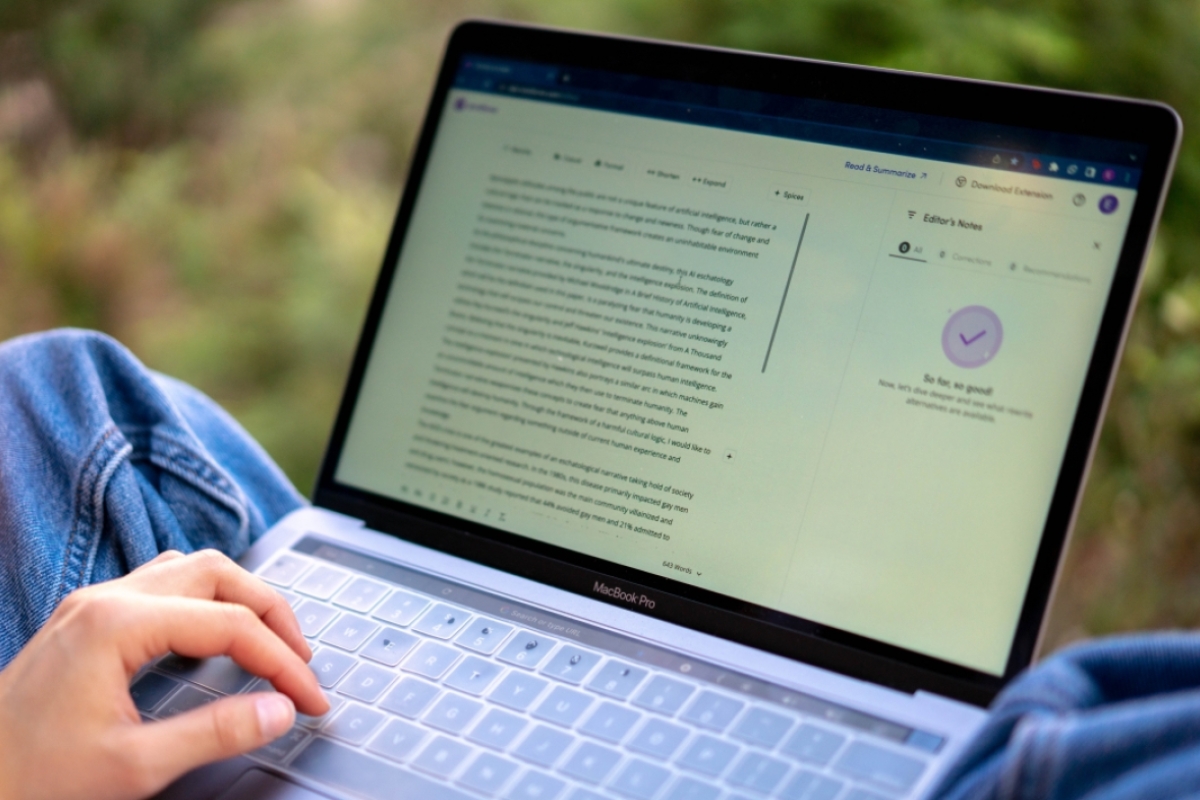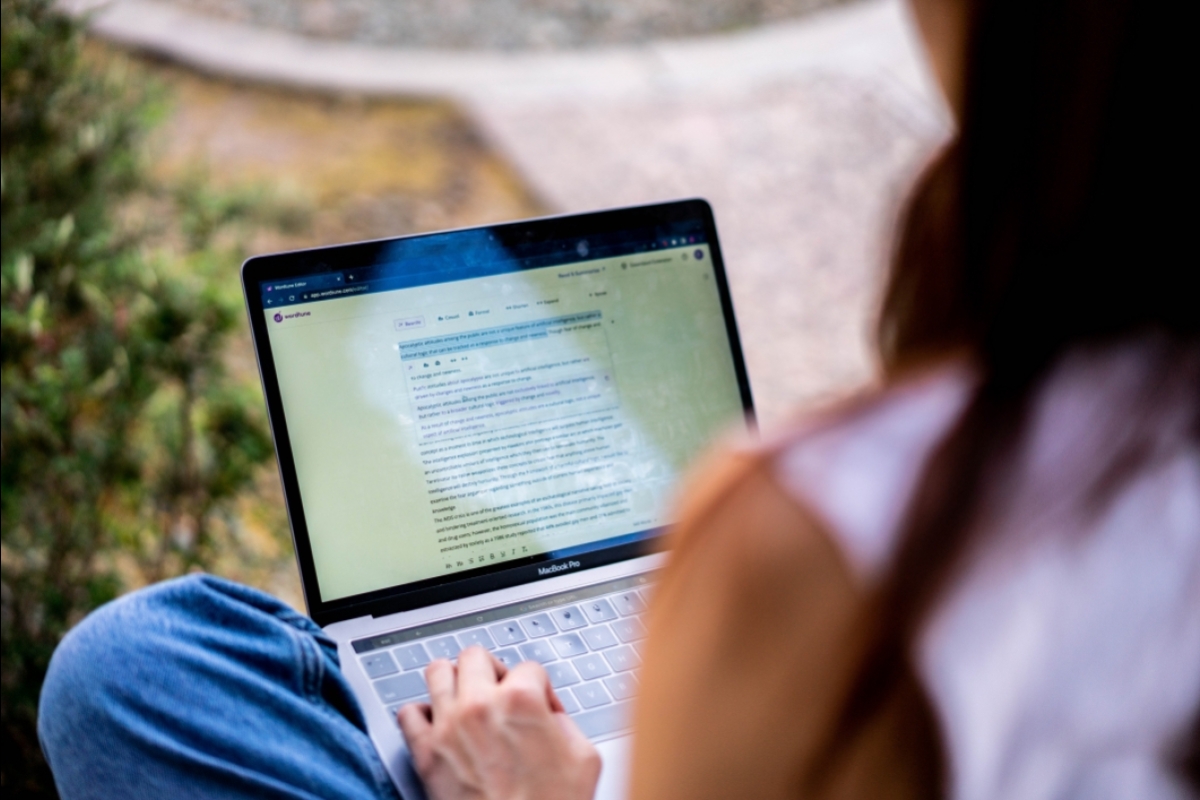ASU students explore ways to embrace AI tools in writing course

Erin Slutzky, a communications major at The College of Liberal Arts and Sciences, harnesses the power of artificial intelligence to refine and optimize her writing process. Photo by Kevin Pirehpour/ASU Enterprise Technology
Students enrolled in an advanced English course at Arizona State University used generative artificial intelligence tools to assist their writing process — from brainstorming ideas to editing drafts.
And when reflecting on the semester, the students shared that it made them better writers.
The adoption of AI tools in the classroom reflects a growing technology trend in higher education. Nevertheless, the emergence of generative AI tools — those capable of using machine learning to provide recommendations or create content, alongside a variety of other tool-specific functionalities — has introduced a wave of disruption, sparking continuous discussions and debates within the academic community.
This experiment to leverage generative AI tools, including ChatGPT, Wordtune and Google Bard, in the ENG 390: Methods of Inquiry writing course last semester provides a glimpse into how future classrooms might increasingly look to machine learning to augment human creativity and critical thinking.
“It's like having a spotlight that highlights each sentence, making me pause and really think about how it adds value to my main idea,” said Erin Slutzky, who studies communications at The College of Liberal Arts and Sciences, where the Methods of Inquiry course was offered during the 2023 spring semester. “But these tools do more than just suggest edits for my writing — it's teaching me to become a more thoughtful and effective writer, carefully considering the value and impact of each sentence I write.”
Recent advancements in AI tools have left many grappling with the future of teaching and learning. And while these new tools may disrupt traditional practices, they also unlock a world of endless possibilities for innovation and exploration.
“We possess the potential to mold the future of AI tools and their role in our lives,” said Courtney Caputo, an English graduate student and course participant. “If we approach it with fear, it will hinder its development as a productive tool. By embracing AI tools — and considering all the ways they can be applied — we can unlock transformative possibilities.”
Rise of generative AI tools
AI, coined in the late 1950s, aimed to equip machines with human-like cognitive abilities. Fast forward to 2012, neural networks — systems that learn through statistical patterns — transformed the field, enabling speech processing, object recognition and language translation.
In 2018, another leap occurred with large language models, which are trained on extensive internet data to mimic the form of written language. These algorithmic models can compose unique text, write code and engage in nuanced conversations — a development now known as generative AI.
Since late 2022, general access to large language models hit an all-time high with generative AI tools, such as ChatGPT, dominating tech headlines.
The AI tools used in the Methods of Inquiry course work alongside students as they write, generating feedback and options for them to make revisions and corrections in real time. This method proves especially helpful when a student encounters a roadblock on a topic.
“Say I’m struggling to identify supporting arguments for a paper and want to explore new perspectives — AI tools enable me to generate fresh ideas and expand my horizons,” said Slutzky. “It encourages me to think beyond the constraints of my current thought process and consider alternative approaches to writing about my topic.”
For more information, visit the Learning Experience playlist for a six-part discussion series on generative AI tools at ASU.
Exploring AI tools in the classroom
“We ought to be trying to help our students invent and evaluate possibilities,” said Kyle Jensen, director of writing programs in The College’s Department of English and who taught the Methods of Inquiry course. “Students can do that in isolation with the technology, but it becomes exponentially more powerful when they do it as a group, as a class.”
In addition to offering real-time feedback, Caputo and her classmates employ AI tools as catalysts for generating writing ideas, which they can then explore in depth in group conversations.
“In those types of collaborative, brainstorming-style discussions, you're sometimes limited to certain sources or your ideas on the subject,” Caputo said. “Having AI tools helped us add more research-based content in real time without disrupting the flow of our conversation.”
Students in the class reported improved writing abilities after incorporating AI tools into their process. By using multiple AI-powered tools for tasks such as generating ideas, organizing content and refining sentence structure, they were able to focus more on developing their analytical and communication skills.
Instructors go back and forth on how to best integrate AI tools in education, primarily when used for writing assignments because of its capacity for cheating or plagiarism. But it is clear that AI tools will alter workflow for many students.
“These technologies are not altogether that threatening if we are genuinely committed to working closely with our students, learning their voice, reading multiple drafts and cultivating a trusting, collaborative relationship,” Jensen said.
Incorporating a network of AI tools in classrooms sets the stage for an intriguing yet intricate new approach to education. As educators and students alike wrestle with the ethical implications of AI tools on academic integrity and overhaul teaching methods, another pivotal issue emerges — digital literacy.
Equipping students for the digital age
Digital literacy, at its core, refers to the ability to navigate, comprehend and use digital tools and platforms effectively. In today’s increasingly connected world, it encompasses skills such as searching for information, discerning reliable sources and engaging in online communication with clarity and respect. It’s the passport to the digital world, empowering individuals to participate fully in the evolving digital society, whether it's for education, communication or work.
“As we navigate the boundless possibilities of AI tools, it’s our responsibility to empower students with the knowledge to wield these technologies wisely,” said Kyle Bowen, executive director of learning experience at ASU’s Enterprise Technology. “By fostering digital literacy and promoting responsible use of AI tools, we equip our learners to become creators, critical thinkers and compassionate stewards of the future.”
One approach to enhancing digital literacy involves gaining a deeper understanding of the technology’s historical development, Jensen said.
“Whenever we use technology — be it a stylus or a smartphone — it’s essential to understand its history and how it works,” he said. “In the past semester, we didn’t just incorporate generative AI tools to diversify our learning methods in the course. We also delved into the history and evolution of artificial intelligence research to better understand how and why the technology functions the way it does.”
The effort to improve digital literacy should, in a perfect world, guide educators and students to a point where AI tools and emerging technologies become less mystifying. In this envisioned future, educators, armed with a better understanding of potential benefits and limitations of AI tools, can responsibly implement its applications in the classroom, transforming AI tools into instruments for enhanced teaching and learning.
Yet, there's still plenty of progress to be made before AI tools are fully integrated into higher education.
“We need to be fastidious in watching and observing the evolution of large language modeling,” Jensen said. “In some ways, the genie’s out of the bottle, but in another way, we don’t even know what the genie is yet, in large because we’re at the nascent stage of large language modeling development.”
More Science and technology

Will this antibiotic work? ASU scientists develop rapid bacterial tests
Bacteria multiply at an astonishing rate, sometimes doubling in number in under four minutes. Imagine a doctor faced with a…

ASU researcher part of team discovering ways to fight drug-resistant bacteria
A new study published in the Science Advances journal featuring Arizona State University researchers has found…

ASU student researchers get early, hands-on experience in engineering research
Using computer science to aid endangered species reintroduction, enhance software engineering education and improve semiconductor…


